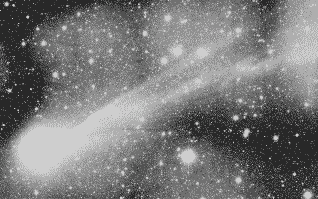
News Release
|
Office of News and Information 212 Whitehead Hall / 3400 N. Charles Street Baltimore, Maryland 21218-2692 Phone: (410) 516-7160 / Fax (410) 516-5251 |
March 20, 1996 CONTACT: Emil Venere esv@resource.ca.jhu.edu |
Astronomers to Capitalize on Rare Comet Visit
 The brightest comet in 20 years is streaking past Earth this
week, and astronomers are using the most powerful telescopes to
learn more about the enigmatic objects.
The brightest comet in 20 years is streaking past Earth this
week, and astronomers are using the most powerful telescopes to
learn more about the enigmatic objects.But Comet Hyakutake (pronounced Eye-ah koo TAH key) also promises to provide a good show for non-astronomers. The Maryland Space Grant Observatory, located on the roof of the physics and astronomy building at Johns Hopkins University, will be open for public viewing of the comet, weather permitting, at 10 p.m. this Thursday and Friday, 9 p.m. on Saturday, and at sunset on Sunday, Monday and Tuesday.
For more information about the observatory schedule, call the consortium at 410-516-7351, or access the observatory's homepage: http://www.pha.jhu.edu/~newcomer/telescope.html.
Also, feel free to call me at the Office of News and Information, at 410-516-7160.
Astronomers will use the Hubble Space Telescope to look at Hyakutake on March 26, and again April 1 through April 4.
"This is a very good time for comet observers, and we have some unusual instruments that have never been used before on a comet this bright, so we're really expecting that the scientific return will be very high, besides providing a very nice show to the casual observer," said Paul Feldman, a Johns Hopkins professor of physics and astronomy.
Ultimately, insights from the encounter will help scientists piece together mysteries surrounding the origins of life on Earth: water and possibly other ingredients vital for life to develop on the primordial planet are believed to have come from comets.
Feldman is among about a dozen astronomers who plan to get a closeup view of the comet's icy center. Hyakutake will come within 9 million miles of Earth, a mere one-tenth the distance to the Sun.
"Because of that, with our telescopes, both on the ground and in space, we can get an unprecedented view of the inner workings of a comet," Feldman said. Astronomers hope to actually focus on the comet's nucleus and measure its size. The only time that has been done before was when European and Soviet spacecraft flew by Halley's Comet in March 1986.
Of course, there was no Hubble telescope then. The space telescope's high sensitivity and resolving power make it ideal for observing comets as they approach the inner solar system.
Comets are too small to be seen from large distances. They populate a huge swarm of comets, called the Oort Cloud, a pool of material left over from the birth of the solar system that extends as far as one light year, or 6 trillion miles, from the Sun. That's one-fourth the distance to the nearest star.
Occasionally, nearby stars exerting gravitational forces kick one of these objects out of its distant orbit, and it comes close to the Sun, Feldman said.
As it gets closer to the inner solar system the Sun's warmth heats up its frozen core, releasing various gases that brighten the comet. Electrically charged particles from the solar wind react with the cometary gases, forming a large tail that always extends directly away from the Sun. By using a spectrometer to study the luminous gases, astronomers can analyze what the core is made of.
"We know that water is there, but there are also many other molecules that are trapped in the ice, and these are the ones that contain carbon and sulfur and various other elements that are absolutely essential for life on Earth," Feldman said. "By looking very close we will have a much better view of these molecules."
Scientists believe that the embryonic Earth had no oceans and that its original atmosphere was blown off into space shortly after the planets were formed. Well-accepted theories paint a scenario in which the oceans and a permanent atmosphere were generated later. Comets collided with Earth, bringing water, and the atmosphere was produced from gases venting from the interior of the planet.
But researchers can't be sure about this scenario until they know which materials were present during the early solar system. Comets are a throwback to those times, 4.5 billion years ago, when the planets were born.
"There are some very deep scientific questions, and every time we have a new comet, we can make an incremental advance, and learn a little bit more," Feldman said.
But, aside from the pure science, Hyakutake represents an unusual opportunity for amateur astronomers: a comet visible to the naked eye. It may be seen in the northeastern sky until around mid-April. "We have to go back almost 20 years to find a naked-eye object that was visible to many people," Feldman said. "That was comet West in 1976. Unfortunately, it was a morning object, and not too many people rose early in the morning to see it."
Hyakutake was named after amateur Japanese astronomer Yuji Hyakutake, who discovered the comet in January with a pair of high-powered binoculars. The comet makes its closest approach to Earth the night of March 24.
"It should be a good show," Feldman said. But he noted that people who intend to look for the comet must get away from the city, where light pollution will prevent a clear view. Don't forget to look for the darkest site you can, and have a clear view to the north and east, he said.
|
Johns Hopkins University news releases can be found on the
World Wide Web at
http://www.jhu.edu/news_info/news/ Information on automatic e-mail delivery of science and medical news releases is available at the same address.
|
 Go to
Headlines@HopkinsHome Page
Go to
Headlines@HopkinsHome Page